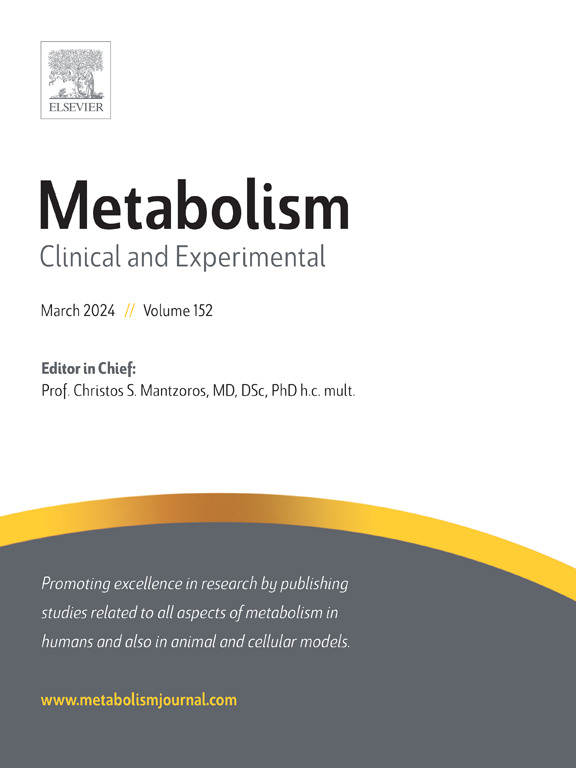不同组织学严重程度的代谢功能障碍相关脂肪性肝病患者的血清脂质体特征。
IF 10.8
1区 医学
Q1 ENDOCRINOLOGY & METABOLISM
引用次数: 0
摘要
背景与目的:代谢功能障碍相关性脂肪性肝病(MASLD)代表了从单纯脂肪变性到脂肪性肝炎、肝纤维化和肝硬化的一系列病理变化。伴有或不伴有纤维化的代谢相关性脂肪性肝炎(MASH)患者发生肝脏和心血管并发症的风险最大。要识别这类高危的代谢相关性脂肪性肝炎(MASLD)患者,医生仍需依赖侵入性肝活检。本研究旨在确定循环脂质体特征,以更好地识别多种族亚洲队列中的MASH患者:研究采用脂质组学方法,对151名新加坡患者的481种血清脂质进行了量化,并配对进行了肝活检。确定了作为 MASLD、MASH 和晚期肝纤维化诊断生物标志物的脂质体特征。210种脂质在不同组织学亚型的MASLD中表现出明显差异。这些脂质大多与肝脏脂肪变性有关(198/210)。我们确定了与肝小叶炎症、气球和严重纤维化相关的 13 种脂质。更具体地说,二己基甘油三酯是明显纤维化的新标记物。仅使用血清脂质组,我们就能对 MASLD 患者(AUROC 0.863)、高危 MASH 患者(AUROC 0.912)和晚期纤维化患者(AUROC 0.95)进行分层。使用 14 个标记物的血脂组学高危 MASH 预测指标得到独立验证(n = 105),AUROC 为 0.76:血脂谱的动态变化与MASLD组织学分期的进展相关,为区分MASLD的分期提供了替代标记物,并确定了发病机制的新途径。本文章由计算机程序翻译,如有差异,请以英文原文为准。
Serum lipidomic signatures in patients with varying histological severity of metabolic-dysfunction associated steatotic liver disease
Background & aims
Metabolic dysfunction-associated steatotic liver disease (MASLD) represents a spectrum of pathologies ranging from simple steatosis to steatohepatitis, fibrosis and cirrhosis. Patients with metabolic associated steatohepatitis (MASH) with fibrosis are at greatest risk of liver and cardiovascular complications. To identify such at-risk MASLD patients, physicians are still reliant on invasive liver biopsies. This study aimed to identify circulating lipidomic signatures to better identify patients with MASH in a multi-ethnic Asian cohort.
Approach & results
A lipidomic approach was used to quantify a total of 481 serum lipids from 151 Singaporean patients paired with protocolized liver biopsies. Lipidomic signatures for MASLD, at-risk MASH and advanced fibrosis were identified. 210 lipids showed significant differences for varying histological subtypes of MASLD. Majority of these lipids were associated with liver steatosis (198/210). We identified a panel of 13 lipids associated with lobular inflammation, ballooning and significant fibrosis. Of note, dihexosylceramides were novel markers for significant fibrosis. Using the serum lipidome alone, we could stratify patients with MASLD (AUROC 0.863), as well as those with at-risk MASH (AUROC 0.912) and advanced fibrosis (AUROC 0.95). The lipidomic at-risk MASH predictor, using 14 markers, was independently validated (n = 105) with AUROC 0.76.
Conclusions
The dynamic shift in serum lipid profile was associated with progressive histological stages of MASLD, providing surrogate markers for distinguishing stages of MASLD as well as identifying novel pathways in the pathogenesis.
求助全文
通过发布文献求助,成功后即可免费获取论文全文。
去求助
来源期刊

Metabolism: clinical and experimental
医学-内分泌学与代谢
CiteScore
18.90
自引率
3.10%
发文量
310
审稿时长
16 days
期刊介绍:
Metabolism upholds research excellence by disseminating high-quality original research, reviews, editorials, and commentaries covering all facets of human metabolism.
Consideration for publication in Metabolism extends to studies in humans, animal, and cellular models, with a particular emphasis on work demonstrating strong translational potential.
The journal addresses a range of topics, including:
- Energy Expenditure and Obesity
- Metabolic Syndrome, Prediabetes, and Diabetes
- Nutrition, Exercise, and the Environment
- Genetics and Genomics, Proteomics, and Metabolomics
- Carbohydrate, Lipid, and Protein Metabolism
- Endocrinology and Hypertension
- Mineral and Bone Metabolism
- Cardiovascular Diseases and Malignancies
- Inflammation in metabolism and immunometabolism
 求助内容:
求助内容: 应助结果提醒方式:
应助结果提醒方式:


